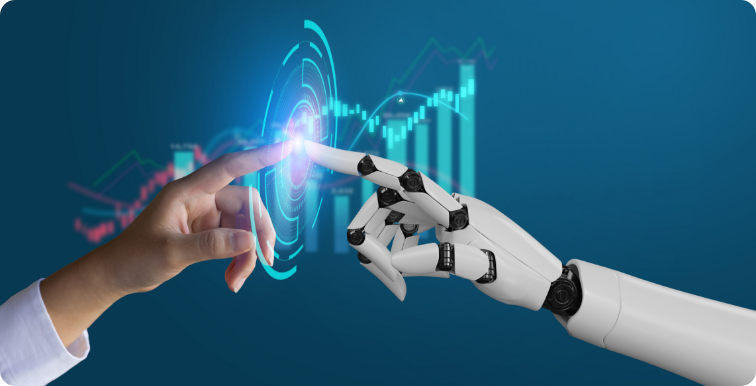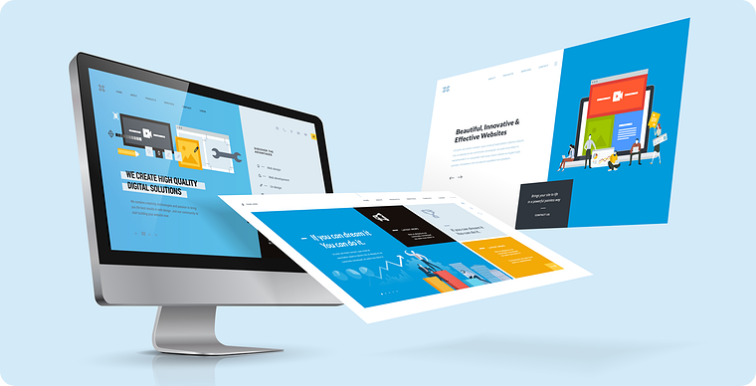It’s high time that we stop pondering over what jobs will AI replace and when it will pass human intelligence. The famous entrepreneur Jack Ma says, “We should use AI to solve problems rather than being controlled by AI.” The billionaire cofounder insists on the “artificial” part of this intelligence by highlighting that we have a heart. We must leverage it to perform better rather than focus on the negatives. Technology is now evolving at a pace like never before, and things are changing very quickly. So, we must adopt the latest change before it progresses further.
Many developers use AI to write codes, find bugs, and build database structures. On the other hand, website designers are utilizing AI tools to create user-friendly interfaces with user-centric features. Overall, AI is helping them to create a seamless and cherishing user experience while embedding performance optimization. With this, let’s discuss the possibilities of using AI to transform web design while reviewing its pros and cons. We will also list some applications that provide a futuristic AI website design with superior functionality and fewer redundancies.
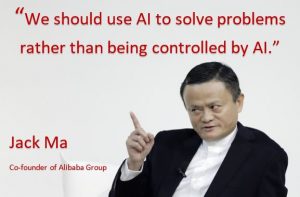
AI Website Design
AI is reshaping the digital arena with tools and components like Chatbots, generative AI, and conversational AI. Whether it is a social media platform, team collaboration apps, or any other industry, none is indifferent to its implications. Likewise, web design is also transforming into a new field with the help of AI tools and components. Professionals are leveraging smart systems and machine learning algorithms to build different website modules. Soon, it would be rare to process a design and development task without using AI-powered tools.
The vast libraries of code and features make it easier to avoid building from scratch. The drag-and-drop no-code platforms allow you to design, terminating the need for coding skills. It brings the concept of Artificial Design Intelligence (ADI), which explains how AI transforms web design. It utilizes machine learning and image or speech processing for several UI/UX design essentials.
1. Artificial Design Intelligence (ADI)
Although it is somewhat different yet connected with the AI web design domain, it sets the path for transformation. Web design templates and presets were previously available for website designers to modify per their needs and preferences. Now, you can produce a unique and fresh design from your idea using AI and ML-powered tools or platforms. Wix, Firedrop, and GoDaddy are some platforms offering personalized design solutions. We are witnessing the next evolution of the digital environment by letting nontechnical minds contribute.
Entrepreneurs and small businesses are exploring new horizons of growth using such platforms and ADI models. Numerous professionals generate content through Bard and ChatGPT, visuals by AI image generators, or videos by websites like Designs.ai. Moreover, the ease of creating a website and customizing its layout encourages many more to kickstart their online ventures. It requires a set of comprehensive commands and features that you want to embed in a layout.
2. ADI for UX Design
Not only are AI tools capable of producing attractive interfaces and content to display, but they also improve functionality. Various ChatGPT and Google Bard plugins enable writing code, finding bugs, architectural layouts, raising security, and SEO optimization. Together, they can uplift the appearance, appeal, and influence of your interfaces while minimizing workflow steps.
Besides, AI can optimize your pages for search engines on performance and loading speed by streamlining procedures. It can help run usability testing to identify improvement areas by analyzing user data. You can also personalize the user experience by incorporating preferences and recommendations. It also helps employ better security policies by analyzing potential risks.
3. ADI for UI Design
The core area that deals with designing interfaces is also modernizing with the advancement of AI technology. Web designers use accurate and functional mockups to provide users with a wide range of design alternatives. Additionally, the high-quality vector graphics by AI image generators allow them to cut production time and require less effort.
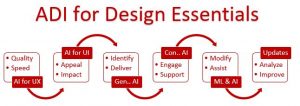
AI helps in deciding the placement of content, menu tabs, images, and other visual design elements in proper areas. Furthermore, it can generate security and functionality-driven code to create responsive designs without bugs. Advanced AI tech by Airbnb allows you to upload design sketches to transform them into fully functional code.
AI Implications for Website Design, AI in Web Design
4. Generative AI for Lead Conversion
Lead generation and conversion are significant business goals that rely on providing sufficient product knowledge. It deals with placing funnels on the website and assisting users with their journey to conversion. Generative AI helps find relevant information inside and outside the organization to assist communication between employees and clients.
It indexes and maintains all the business and industry data customers might ask to present in real time. For instance, AI-powered calls allow the AI to identify and present product specifications, saving time and effort. The customer gets a rapid response, encouraging them to proceed in the sales pipeline or buy a product.
5. Conversational AI for Help and Support
The Natural Language Processing (NLP) models equip your website pages with chatbots, voice assistants, or gesture controls. It helps use voice, speech, or gesture inputs and reply to queries and concerns in a Human-like language. Many businesses are adopting these AI tools to offer quicker help and support to their clientele or visitors. It enables necessary facilities to collect feedback, process queries, provide information, and guide users. They also improve the public engagement on site pages, giving enough information to assist them in making a buying decision.
6. Machine Learning for Recommendations
Another crucial AI feature for website design is using machine learning algorithms to track and predict user behavior. It stores past user choices, recognizes their buying patterns, and provides recommendations based on their preferences. It helps declutter screens of irrelevant ads and buying prompts by only mentioning the suitable options. Users can enjoy a personalized shopping experience and purchase according to their buying patterns and tastes. It also enables faster checkout mechanisms by quick processing, like presenting past grocery lists or repeat orders.
7. Analytics and Modernization
Several AI tools allow for running analytic scans and diagnostics on web pages to find and resolve issues. It tracks user annoyance and aggressive gestures by inspecting bounce rates and heat signatures (repetitive clicks or cursor movements). Problem identification assists in implementing proposed solutions by these tools and other significant overhauls if necessary. Modernizations are a vital concern that disrupts user experience, so AI utilizes optimized infrastructure and ML tools. It helps modernize apps with AI-powered tools such as Azure OpenAI Service. 79% of executives claim that using generative AI to update apps will increase business agility (IBM).
Must-Try AI Applications for Web Designers
With such benefits and promising results, AI applications are the way to a futuristic web design and development. All in all, the implications of AI in designing websites offer a fluent design process by aligning all design elements. The following are four must-try AI applications for web designers, regardless of their skill or proficiency.
1. Figma
The all-inclusive platform for design projects allows teams to collaborate and contribute to the project. To proceed swiftly, it hosts a list of design essentials, including web page design and prototyping. The key features of Figma comprise APIs, animations, design templates, image editing, and testing for usability or performance. It supports CAD designers with various tools and allows importing or exporting data for other usages. Design engineers can use management and collaboration tools for working in teams remotely from different time zones.
Must Try AI Applications for Web Designers
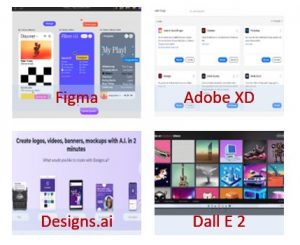
2. Adobe XD
The design tool by Adobe assists in creating prototypes and page layouts to support solo tasks as well as team projects. Its design assets library is a distinct resource that provides fonts, colors, and component choices that you can upgrade or modify. The tool is flexible with low and high-fidelity design alternatives that can enrich your web page’s UI UX design. Key features of Adobe XD are wireframing, code hints, visual aids, Git integration, and a simple yet modern interface.
3. Designs.ai
The online platform offers an array of design options for text, logos, images, videos, websites, and social media pages. It also has an AI-enabled voiceover tool to improve video scripts and audio brand messages. Irrespective of technical knowledge, the platform can develop consistent branding and marketing strategy material in a couple of minutes. The key features are the smart editor, wizard tool, font/color styles, vector graphics, and visual design.
4. Dall E 2
Dall E 2 is a powerful system from the famous ChatGPT provider OpenAI. It uses natural language processing (NLP) to convert text into images and visuals. You can use it to edit or scale images, generate appealing visuals, or customize images through text to add visuals. The tool’s key features are high resolution, in or out painting, unifying concepts or styles, and precise diffusion. It saves the extra time for designing essential visuals to enrich website functionality and appeal.
What’s the Future of AI Web Design?
The future of web design is anything but boring, as AI reduces work intensity, design time, and, most importantly, cost. Web design costs will have a significant impact on small businesses that are searching for affordable web designers or cheap website designs. It will eliminate the need to hire a website designer or reduce it to a micro level, allowing them an easy online entry.
The elements of web design will get a cutting-edge makeover by providing text, speech, and drag-and-drop features. Moreover, it will revolutionize how small business ideas impact the online marketplace by assisting their growth. The following possibilities will further enhance the design endeavors using AI applications and tools.
1. Easy AI Integrations
Imagine the possibility of connecting with apps and platforms just by selecting their names and desirable fields. It would be a breakthrough in designing websites without any coding and skill in database architecture. A simple website will be capable of extraordinary functionality, making the user journey easier and worth experiencing. It is a reality now, as AI integration is available.
2. Voice User Interfaces
Voice assistants make lives easier and safer (while driving) by responding to voice commands to call, text, or use apps. What if users can speak the names of items to shop online and add them to their cart for checkouts? It is becoming a reality, with websites using AI tools to facilitate a swift shopping experience. Moreover, you can embed AI videos of user manuals and how to do it to assist your prospects further.
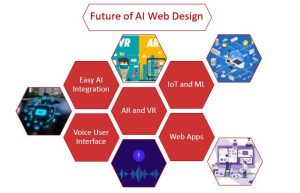
3. AR and VR Environments
Considered to be one of the most expensive technologies, AR and VR environments are becoming more common. With the help of AI, you can add augmented reality (AR) and virtual reality (VR) features to your website. It helps clients try out dress sizes or color options, seek guidance, and experience what they aim to buy. Web designers can provide immersive features within or outside the pages to increase engagement and encourage conversions.
4. IoT and Smart Buildings
Imagine the users can use a physical store-like environment to explore available inventory or scan your product for necessary details. The Internet of Things (IoT) connects websites with smart buildings like homes, offices, or facilities to provide a fantastic user experience. It leverages the input of sensors to determine the conditions or dimensions while proposing suitable products. Meanwhile, the users can evaluate the impact of products on sustainable living and procedures.
5. Web App Development
Apps are a great tool to get closer to prospects via handheld devices, and they aren’t leaving any soon. Web app development with AI features will uplift your mobile app design and development projects with futuristic user experiences. The website caters to the diverse needs of desktop and mobile users, while web app development generates a responsive design. Together, all features will engage more audiences on web and app platforms and bring a better return on investment.
Conclusion
The writing discusses how AI transforms web design by explaining the different aspects and essentials of web design. It provides insight into using AI website design elements and tools while mentioning the four must-try applications. Moreover, it covers the future of web design by highlighting the latest tech stack and limitless possibilities. You can discuss your design ideas with us or kickstart your dream business online by selecting a web designer for hire. Follow our blogs for more insights on web design and development, small business ideas, branding, or rebranding.


